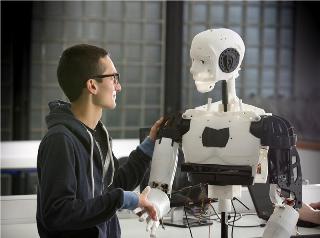Oct 15 2015
Humans are less likely to form successful working relationships with interactive robots if they are programmed to be too perfect, new research reveals.
 University of Lincoln - MARC the 3D printed robot
University of Lincoln - MARC the 3D printed robot
Interactive or ‘companion’ robots are increasingly used to support caregivers for elderly people and for children with autism, Asperger syndrome or attachment disorder, yet by programming their behaviour to become more intelligent we could in fact be creating barriers to long-term human-robot relationships, the research suggests.
Conducted by robotics experts from the University of Lincoln, UK, the study found that a person is much more likely to warm to an interactive robot if it shows human-like ‘cognitive biases’ - deviations in judgement which form our individual characteristics and personalities, complete with errors and imperfections.
The investigation was conducted by PhD researcher Mriganka Biswas and overseen by Dr John Murray from the University of Lincoln’s School of Computer Science. Their findings were presented at the International Conference on Intelligent Robots and Systems (IROS) conference in Hamburg in October 2015.
Mriganka said: “Our research explores how we can make a robot’s interactive behaviour more familiar to humans, by introducing imperfections such as judgemental mistakes, wrong assumptions, expressing tiredness or boredom, or getting overexcited. By developing these cognitive biases in the robots – and in turn making them as imperfect as humans – we have shown that flaws in their ‘characters’ help humans to understand, relate to and interact with the robots more easily.”
Currently most human-robot interaction is based on a set of well-ordered and structured rules and behaviours. However the Lincoln academics used a technique new to robotics research, which involved introducing the cognitive biases ‘misattribution of memory’ and ‘empathy gap’ – which traditionally play a significant role in human interactions and relationships – to two different robots.
The investigation involved Dr Murray’s robot ERWIN (Emotional Robot with Intelligent Network), which has the ability to express five basic emotions, and Keepon, a small yellow robot designed to study social development by interacting with children.
The researchers examined a number of interactions between the robots and human participants. During half of the interactions the robots were not affected by cognitive biases, but during the remainder, ERWIN made mistakes when remembering simple facts (using verbal abilities and expressions) and Keepon showed extreme happiness or sadness (using various movements and noises).
The participants were then asked to rate their experiences, and the results revealed that almost of all of those taking part enjoyed a more meaningful interaction with the robots when they made mistakes.
“The cognitive biases we introduced led to a more humanlike interaction process,” Mriganka explained. “We monitored how the participants responded to the robots and overwhelmingly found that they paid attention for longer and actually enjoyed the fact that a robot could make common mistakes, forget facts and express more extreme emotions, just as humans can.
“The human perception of robots is often affected by science fiction; however there is a very real conflict between this perception of superior and distant robots, and the aim of human-robot interaction researchers. A companion robot needs to be friendly and have the ability to recognise users’ emotions and needs, and act accordingly. Despite this, robots used in previous research have lacked human characteristics so that users cannot relate - how can we interact with something that is more perfect than we are?
“As long as a robot can show imperfections which are similar to those of humans during their interactions, we are confident that long-term human-robot relations can be developed.”
The results of this study pave the way for the next phase of Mriganka’s PhD research, which will investigate whether using robots that show cognitive bias in a similar way, but which look more human-like, develops even more successful relationships. Mriganka’s current studies involve MARC (Multi-Actuated Robotic Companion), Dr Murray’s 3D-printed humanoid robot. The design of MARC is supplied by the open source project InMoov (www.inmoov.fr).
Previous research suggests that the appearance of humanoid robots helps users to understand their gestures more intuitively. Hand movements, body language and speech are easy for the human sensory system to interpret straight away as they have been practised since childhood. Mriganka will research whether this familiarity, coupled with cognitive biases and humanlike faults, will stimulate even more positive reactions from users.